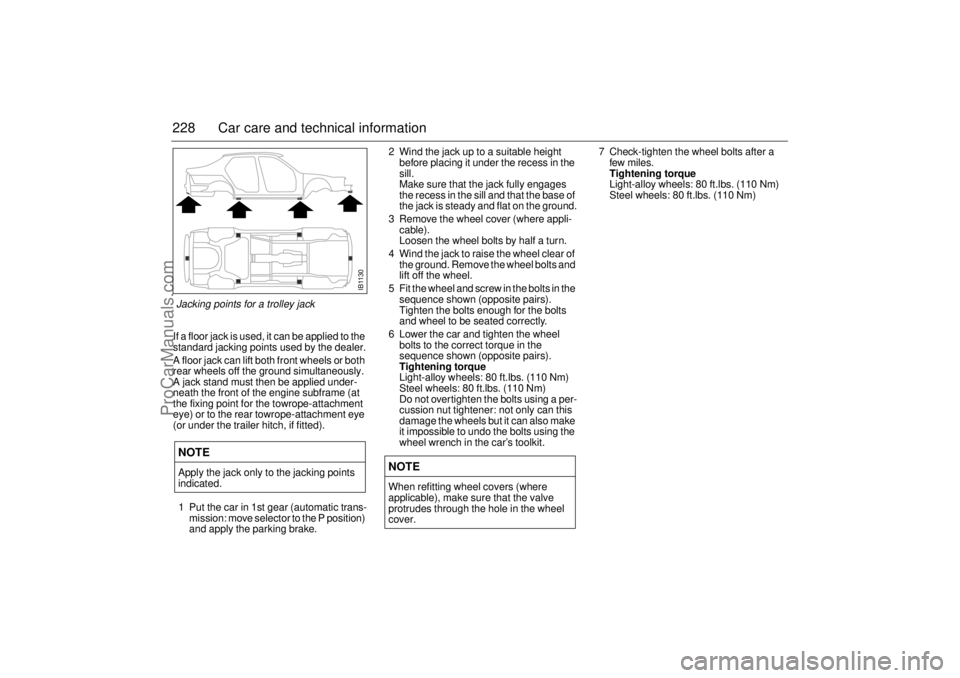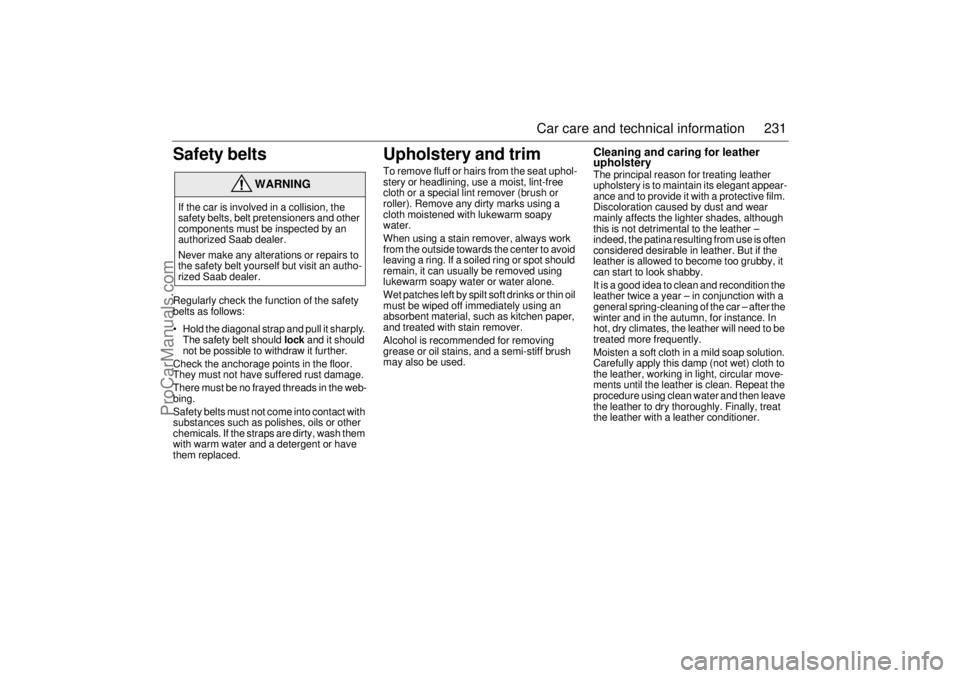2001 SAAB 9-5 tow
[x] Cancel search: towPage 228 of 272

228 Car care and technical informationIf a floor jack is used, it can be applied to the
standard jacking points used by the dealer.
A floor jack can lift both front wheels or both
rear wheels off the ground simultaneously.
A jack stand must then be applied under-
neath the front of the engine subframe (at
the fixing point for the towrope-attachment
eye) or to the rear towrope-attachment eye
(or under the trailer hitch, if fitted).
1 Put the car in 1st gear (automatic trans-
mission: move selector to the P position)
and apply the parking brake.2 Wind the jack up to a suitable height
before placing it under the recess in the
sill.
Make sure that the jack fully engages
the recess in the sill and that the base of
the jack is steady and flat on the ground.
3 Remove the wheel cover (where appli-
cable).
Loosen the wheel bolts by half a turn.
4 Wind the jack to raise the wheel clear of
the ground. Remove the wheel bolts and
lift off the wheel.
5 Fit the wheel and screw in the bolts in the
sequence shown (opposite pairs).
Tighten the bolts enough for the bolts
and wheel to be seated correctly.
6 Lower the car and tighten the wheel
bolts to the correct torque in the
sequence shown (opposite pairs).
Tightening torque
Light-alloy wheels: 80 ft.lbs. (110 Nm)
Steel wheels: 80 ft.lbs. (110 Nm)
Do not overtighten the bolts using a per-
cussion nut tightener: not only can this
damage the wheels but it can also make
it impossible to undo the bolts using the
wheel wrench in the car’s toolkit. 7 Check-tighten the wheel bolts after a
few miles.
Tightening torque
Light-alloy wheels: 80 ft.lbs. (110 Nm)
Steel wheels: 80 ft.lbs. (110 Nm)NOTEApply the jack only to the jacking points
indicated.
NOTEWhen refitting wheel covers (where
applicable), make sure that the valve
protrudes through the hole in the wheel
cover.
IB1130
Jacking points for a trolley jack
ProCarManuals.com
Page 231 of 272

231 Car care and technical information
Safety beltsRegularly check the function of the safety
belts as follows:
Hold the diagonal strap and pull it sharply.
The safety belt should lock and it should
not be possible to withdraw it further.
Check the anchorage points in the floor.
They must not have suffered rust damage.
There must be no frayed threads in the web-
bing.
Safety belts must not come into contact with
substances such as polishes, oils or other
chemicals. If the straps are dirty, wash them
with warm water and a detergent or have
them replaced.
Upholstery and trimTo remove fluff or hairs from the seat uphol-
stery or headlining, use a moist, lint-free
cloth or a special lint remover (brush or
roller). Remove any dirty marks using a
cloth moistened with lukewarm soapy
water.
When using a stain remover, always work
from the outside towards the center to avoid
leaving a ring. If a soiled ring or spot should
remain, it can usually be removed using
lukewarm soapy water or water alone.
Wet patches left by spilt soft drinks or thin oil
must be wiped off immediately using an
absorbent material, such as kitchen paper,
and treated with stain remover.
Alcohol is recommended for removing
grease or oil stains, and a semi-stiff brush
may also be used.
Cleaning and caring for leather
upholsteryThe principal reason for treating leather
upholstery is to maintain its elegant appear-
ance and to provide it with a protective film.
Discoloration caused by dust and wear
mainly affects the lighter shades, although
this is not detrimental to the leather –
indeed, the patina resulting from use is often
considered desirable in leather. But if the
leather is allowed to become too grubby, it
can start to look shabby.
It is a good idea to clean and recondition the
leather twice a year – in conjunction with a
general spring-cleaning of the car – after the
winter and in the autumn, for instance. In
hot, dry climates, the leather will need to be
treated more frequently.
Moisten a soft cloth in a mild soap solution.
Carefully apply this damp (not wet) cloth to
the leather, working in light, circular move-
ments until the leather is clean. Repeat the
procedure using clean water and then leave
the leather to dry thoroughly. Finally, treat
the leather with a leather conditioner.
WARNING
If the car is involved in a collision, the
safety belts, belt pretensioners and other
components must be inspected by an
authorized Saab dealer.
Never make any alterations or repairs to
the safety belt yourself but visit an autho-
rized Saab dealer.
ProCarManuals.com
Page 246 of 272

246 Maintenance and owner assistance* These are the minimum required Emission Control System maintenance steps. Saab urges that all recommended maintenance procedures be performed
according to this program.
(b.) Change automatic transmission fluid at more frequent intervals (20,000; 50,000; 80,000 miles, etc.) if car is driven in dense city traffic where the outside
temperature regularly reach 90°F or higher, or if car is used in a mountainous/high altitude area or for trailer towing.
Service Intervals **
Miles = U.S. Cars
Kilometers = Canadian Cars
30 day
10,000
(16,000 km)
20,000
(32,000 km)
30,000
(48,000 km)
40,000
(64,000 km)
50,000
(80,000 km)
60,000
(96,000 km)
70,000
(112,000 km)
80,000
(128,000 km)
90,000
(144,000 km)
100,000
(160,000 km)
Service #
1234567891011
Engine and engine compartment (cont.)
E Evaporative emission system including filler cap, vapor
lines, EVAP canister and canister purge valve"
R Fuel system: leaks and damage""""""""""
E Fuel filter!
E Engine air cleaner element!
*
!*
!*
R Exhaust system and mountings; leaks and condition""""""""""
Electrical
R Battery: state of charge and electrolyte level; clean termi-
nals if necessary"""""""""""
R Head, fog, brake, tail, turn signal, warning lights instru-
ment panel, backup and marker lamps"""""""""""
Transmission
R Automatic transmission fluid change (b.)!!!
R Automatic transmission oil level"""""""""""
R Manual transmission oil level"""
R Outer and inner driver joint boots""""""""""
ProCarManuals.com
Page 251 of 272

251 Specifications
Trailer:
Luggage compartment
Volume (SAE):
9-5 Sedan _______________________ 15.9 cu.ft.
(450 litres)
9-5 Wagon, rear seat upright ________ 31.4 cu. ft.
(890 litres)
9-5 Wagon, rear seat folded _________ 73.0 cu. ft.
(2067 litres)
Maximum permissible luggage-compart-
ment load:
At curb weight + 4 passengers at 154 lbs.
(70 kg) _________________________ 176 lbs (80 kg)
or each passenger fewer in the rear seat, the load may be
increased by 110 lbs (50 kg).
With entire rear seat lowered ________ 594 lbs (270 kg)
Luggage compartment, length, 9-5 Sedan:
Rear seat upright _________________ 43.0 in (1092 mm)
Rear seat folded down _____________ 67.5 in (1714 mm)
Luggage compartment, length, 9-5 Wagon:
Rear seat upright _________________ 42.8 in (1087 mm)
Rear seat folded __________________ 61.2 in (1732 mm)
WARNING
The GVW and maximum axle loads must not be exceeded. Note
that if some accessories (e.g. towbar, CD changer) are fitted, the
available load capacity is reduced by the weight of these.
When carrying a load in the luggage compartment, make sure that
it is tied down securely, particularly when part or all of the rear seat
is folded down.
Maximum towing speed, trailer with brakes 60 mph (100 km/h)
Trailer with brakes _________________ Maximum weight:
3500 lbs (1588 kg)
Trailer without brakes ______________ Maximum weight:
1000 lbs (450 kg)
Maximum load on ball hitch __________ 165 lbs (75 kg)
The above speed and weight restrictions are those specified by
Saab Automobile AB.
Note that local restrictions may apply to trailer speeds and
weights (see page 174).
ProCarManuals.com
Page 266 of 272

266 IndexSteering, technical data
__________ 256
Stone-chip damage, repairing
______ 233
Storage compartments
___________ 131
Sun visors
_____________________ 130
Sunroof
_______________________ 128
Suspension
____________________ 256
Suspension, technical data
________ 256
Switches
_______________________ 63
Systems, adjustment
____________ 261
TTCS OFF
______________________ 53
Table of fuses __________________ 217
Tachometer
_____________________ 54
Tailgate, opening
________________ 38
Tank gauge
_____________________ 55
Technical data _________________ 249
Telematics
____________________ 107
Temperature control, ACC
_________ 72
Temperature gauge, engine ________ 55
Temperature zones, ACC
__________ 72
Textile carpeting
________________ 232
Through-load hatch ______________ 136
Tie Downs
_____________________ 136
Tightening torque, wheel studs
_____ 226
Tire markings
_____________ 221
, 222
Tire pressure
______________ 179
, 221
Tires
____________________ 221
, 257
Tools
_________________________ 144
Touching-in the paintwork
_________ 233
Towbar attachment
______________ 174Towbar load
___________________176
Towing the car _________________181
Towing, automatics
______________181
Traction
_______________________169
Trailer weights
__________________251
Trionic
________________________191
Trip computer
___________________57
Trip meter
______________________54
Trunk
_________________________134
Trunk lid, opening
________________38
Turbo gauge
____________________56
Turbo, points to note
_____________151
UUnder the hood, 3.0t V6
__________190
Under the hood, 4-cyl
____________189
Upholstery and trim
______________231
Upholstery and trim, care of
_______231
Useful tips, ACC
_________________78
VVanity mirrors
__________________130
Ventilated front seats
____________123
Viscosity, engine oil
_____________252
WWarning labels
___________________8
Warning light, AIR BAG
___________30
Warning lights
___________________48
Warning triangle ________________144Washers
_____________________ 203
Washers, windshield
____________ 204
Washing the car
_______________ 232
Waxing and polishing
___________ 233
Wear indicators, tires ____________ 223
Wheels and tires
___________ 221
, 257
Wheels and tires, sizes
__________ 257
Window-glass sensor, car alarm
____ 42
Windshield washers
_____________ 68
Windshield wipers
_______________ 68
Wiper blades, headlamp
_________ 203
Wiper blades, replacing __________ 203
Wipers and washers
_________ 68
, 203
ProCarManuals.com